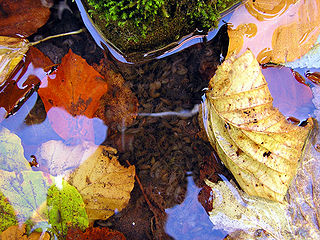
Amphipoda is an order of malacostracan crustaceans with no carapace and generally with laterally compressed bodies. Amphipods range in size from 1 to 340 millimetres and are mostly detritivores or scavengers. There are more than 9,900 amphipod species so far described. They are mostly marine animals, but are found in almost all aquatic environments. Some 1,900 species live in fresh water, and the order also includes the terrestrial sandhoppers such as Talitrus saltator and Arcitalitrus sylvaticus.
Monoporeia affinis,, is a small, yellowish benthic amphipod living in the Baltic Sea, the Arctic Sea and the lakes of the Nordic countries.

Themisto gaudichaudii is an amphipod crustacean of the suborder Hyperiidea.
Paracorophium is a genus of amphipods in the family Corophiidae.
Paraleptamphopus is a genus of amphipods in the family Paraleptamphopidae endemic to New Zealand. The first species to be described was Calliope subterraneus which was named by Charles Chilton in 1882. George M. Thomson described a second species in 1885, as Pherusa coerulea. Although no other species have yet been formally described, it is thought that many more undescribed species exist.
Paracalliope is a genus of amphipod crustaceans that live in Australasia. They include the most common freshwater amphipods in New Zealand, where they are particularly frequent in slow-flowing reaches of rivers. They shelter among weed beds and are important prey items for fish such as the New Zealand smelt, Retropinna retropinna, which are in turn important prey for the freshwater eels Anguilla australis and Anguilla dieffenbachii. Paracalliope acts as an intermediate host for the nematode Hedruris spinigera, which can thus reach their primary host, the eel.
Paracrangonyx is a genus of amphipods in the family Paracrangonyctidae, comprising two species, Paracrangonyx compactus and Paracrangonyz winterbourni.

Gammarus pulex is a species of amphipod crustacean found in fresh water across much of Europe. It is a greyish animal, growing to 21 mm (0.83 in) long.

Allocrangonyx is a genus of troglobitic amphipod crustaceans from the South Central United States. The two species are both listed as vulnerable on the IUCN Red List. The animals are blind and unpigmented. During the male's development, the outer ramus of the third uropod differentiates into secondary segments and grows to a length greater than the animal's body length.

Crangonyctidae is a family of cave-dwelling freshwater amphipod crustaceans. It contains the following genera:

Stygobromus kenki is a rare species of amphipod, a crustacean. Its common names include Kenk's amphipod, Rock Creek groundwater amphipod, and Rock Creek stygobromid.
Édouard Chevreux was a French carcinologist.

Nikolai Mikhailovich Knipovich was a Russian and Soviet ichthyologist, marine zoologist and oceanographer, notable as the founder of fisheries research in the Russian North.

Elsie Wilkins Sexton was an English zoologist and biological illustrator.

Talitrida is an infraorder of amphipods in the subclass Senticaudata.
Pseudamphithoides incurvaria is a species of amphipod crustacean in the family Ampithoidae. It is native to shallow water in the tropical western Atlantic Ocean where it creates a home for itself from fragments of the algae on which it feeds. This seaweed contains certain chemicals that are distasteful and protect it from predatory fish.
Rakiroa is a monotypic genus of amphipods belonging to the monotypic family Rakiroidae. The only species is Rakiroa rima. Both genus and species were first described in 1982 by James K. Lowry and Graham David Fenwick.

Cystisoma is a genus of amphipod. It is the only member of the family Cystisomatidae within the Hyperiidea. The genus is noted for its nearly completely transparent body, adapted for life in low light waters.









